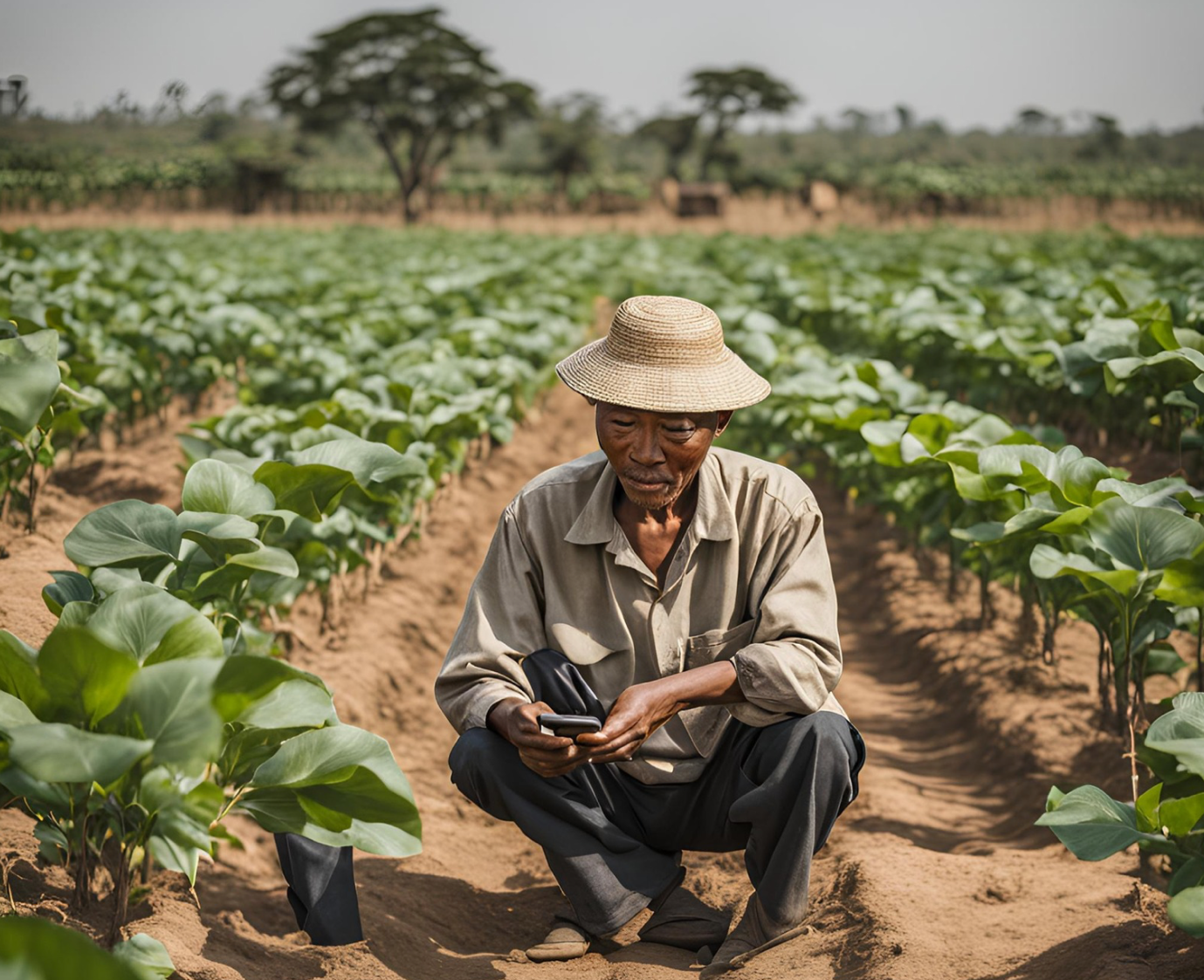Empowering Smallholder Farmers in Data-Driven Agriculture Through Blockchain Technology
The fourth agricultural revolution, driven by digital technologies such as machine learning, IoT, and blockchain, aims to enhance global agricultural output. However, it has been criticised for not adequately benefiting smallholder farmers. Blockchain technology can improve smallholder livelihoods by reducing transaction costs, enabling direct interactions with supply chain actors, and enhancing the traceability of commodities. Unfortunately, existing implementations have not fully delivered on these promises.
In his master’s thesis, “Empowering Smallholder Farmers in Data-driven Agriculture through Blockchain Technology,” Daniel Acosta Stasiukynas, MSc Sustainability Science, Policy & Society graduate, explored blockchain technology and its potential to benefit smallholder farmers. In this blog, he summarises his findings.

The Fourth Agricultural Revolution: Leveraging Digital Technologies for Smallholder Farmers
A fourth agricultural revolution is currently underway, known as data-driven agriculture. The introduction of agrochemicals in the mid-twentieth century led to a surge in yields and a reduction in global hunger (Malo, 2023); the integration of new digital technologies into agricultural practice is also expected to enhance agricultural output worldwide in the twenty-first century. The fourth agricultural revolution is based on integrating new digital technologies, including machine learning, the Internet of Things, and blockchain technology. Despite the productivity gains resulting from this fourth agricultural revolution, there has been significant criticism of the fairness aspect of this development (Ferris & Rahman, 2017). In general, smallholder farmers, the most vulnerable actors in global agricultural supply chains, have not benefited as much as other types of farmers from this development precisely because of their structurally disadvantaged position. Smallholder farmers are typically impoverished, lack access to basic infrastructure, and have relatively low productivity levels (Harvey et al., 2014). It is clear that smallholder farmers' farming practices and livelihoods must be improved if sustainable development objectives such as eradicating poverty and hunger are to be achieved (Terlau et al., 2019). Therefore, it is vital to assess how these technologies can be leveraged to the advantage of smallholder farmers to achieve sustainable development. In this blog, I investigate how blockchain technology can be employed in smallholder agriculture.
Exploring Blockchain's Role in Supporting Smallholder Farmers
In the context of data-driven agriculture, blockchain technology serves several purposes. It can be used as a permanent and accessible registry of all processes occurring throughout the value chain, which can then be operationalised through other technologies for different applications (Kamble et al., 2020). In addition, it can act as an interface to connect, manage and enable new types of interactions between different actors along the supply chain (Zamani & Giaglis, 2018). Data-driven agriculture can potentially improve smallholder farmers' livelihoods in several ways when integrated into this field. Firstly, it can reduce the costs of commercial transactions between farmers and other supply chain stakeholders. Secondly, it can provide consumers with the ability to trace their produce. Thirdly, it can facilitate semi-automated decision-making for smallholder farmers, equipping them with the knowledge to select the most appropriate crops, cultivate them effectively and plan their planting schedules. By examining the impact of blockchain technology on these mechanisms, it is possible to develop data-driven agriculture applications that improve the livelihoods of smallholder farmers.
Reducing Transaction Costs with Blockchain Technology
Integrating blockchain technology into data-driven agriculture primarily benefits smallholder farmers by reducing transaction costs, which improves their livelihoods. High market transaction costs have traditionally excluded these farmers from market participation. Blockchain allows direct interactions between farmers and supply chain stakeholders, eliminating intermediaries and lowering costs. Applications like Hello Tractor and Agrikore exemplify this by providing access to mechanised services and financing, thereby boosting productivity and making services more economically accessible for smallholders.
Enhancing Produce Traceability through Blockchain
In terms of produce traceability, the extent to which blockchain technology can enhance the livelihoods of smallholders is a more nuanced issue. It should be noted that efficiency gains are only observable in applications designed to encompass the totality of the value chain. Applications such as AgriUT or Agrikore achieve this by recording and making transparent the commercial terms to which smallholder farmers are subject. This allows consumers to exert pressure for fairer commercial conditions for smallholders. However, these benefits could be further enhanced by recording additional information that generates utility for consumers, such as using agricultural inputs. This would allow consumers to exercise their willingness to pay price premiums for agricultural practices that align with their normative views (Sammer & Wüstenhagen, 2006). Such applications must be complemented with consumer-friendly interfaces so that consumers can easily access this information.
Shortcomings in Blockchain-Enabled Decision-Making Applications
The current applications using blockchain technology have failed to fulfil their promise of semi-automated decision-making for smallholders. Despite leveraging blockchain technology, they have not provided the necessary knowledge about the optimal crop selection, best cultivation practices, and effective planting schedules. This type of application requires more complex interactions with other technologies, such as the Internet of Things and machine learning, as well as more complex data collection practices. In theory, the blockchain could be the backbone for storing relevant information. However, such applications should be designed so that information about the physical conditions in the fields, climatic models, and other real-world data inputs are collected and stored on the blockchain, which will later be operationalised for semi-automated decision-making. Data-driven agricultural applications have yet to be designed to meet such conditions.
Overall, it seems that blockchain technology can be leveraged in the context of data-driven agriculture to improve the livelihoods of smallholder farmers. This could be done either by generating disintermediation and reducing transaction costs for smallholder farmers regardless of the scope of the application or by enhancing supply chain traceability in applications that encompass the totality of the value chain.
If you want to read Daniel's thesis, you can download it by clicking here. If you want to contact him, you can do this via LinkedIn.
References
Ferris, L., & Rahman, Z. (2017). Responsible data in agriculture. F1000Research, 6(1306), 1306.
Harvey, C. A., Rakotobe, Z. L., Rao, N. S., Dave, R., Razafimahatratra, H., Rabarijohn, R. H., Rajaofara, H., & MacKinnon, J. L. (2014). Extreme vulnerability of smallholder farmers to agricultural risks and climate change in Madagascar. Philosophical Transactions of the Royal Society B: Biological Sciences, 369(1639), 20130089.
Kamble, S. S., Gunasekaran, A., & Gawankar, S. A. (2020). Achieving sustainable performance in a data-driven agriculture supply chain: A review for research and applications. International Journal of Production Economics, 219, 179-194. https://doi.org/https://doi.org/10.1016/j.ijpe.2019.05.022
Malo, M. (2023). GREEN REVOLUTION OR THIRD AGRICULTURAL REVOLUTION: POSITIVE AND NEGATIVE IMPACTS ON AGRICULTURE.
Sammer, K., & Wüstenhagen, R. (2006). The influence of eco‐labelling on consumer behaviour–Results of a discrete choice analysis for washing machines. Business strategy and the environment, 15(3), 185-199.
Terlau, W., Hirsch, D., & Blanke, M. (2019). Smallholder farmers as a backbone for the implementation of the Sustainable Development Goals. Sustainable Development, 27(3), 523-529. https://doi.org/https://doi.org/10.1002/sd.1907
Zamani, E. D., & Giaglis, G. M. (2018). With a little help from the miners: distributed ledger technology and market disintermediation. Industrial Management & Data Systems, 118(3), 637-652. https://doi.org/10.1108/IMDS-05-2017-0231
Also read
-
The project 'Epistemic Imaginaries' will study how within research fields ideas about 'where to go' emerge, stabilize and change under external pressure, such as the climate crisis.
-
Emilie Sitzia has received a Cambridge Visual Culture Visiting Research Fellowship to work on a project titled ‘Common Sense: (Re)inventing a Social and Sensory Museology of the Illustrated Book’.
-
The jury applauds the book for its "original exploration into the materiality of medical knowledge reproduction."


